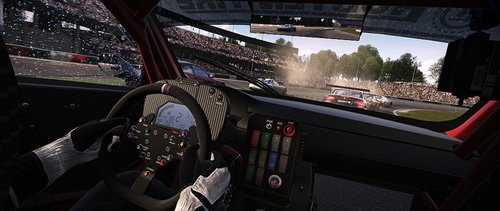It’s been a few years now that virtual reality has been gaining buzz. Palmer Luckey first launched the Oculus Rift Kickstarter in the summer of 2012, and I’ve been anxiously waiting ever since.
Virtual Reality, to me, seemed like a natural progression in video games, and more so simulation games. Being an avid racing game fan, and having spent a small fortune on a racing wheel and accessories, it seemed self-evident to me that simulation games would see the biggest benefit and earliest adoption in virtual reality. I mean, what better way to feel fully immersed than to have physical objects that match up with the virtual world like a steering wheel?
I’ve been following the devolpment and progression of the virtual reality industry and I’ve been puzzled to say the least. Contrary to my first thoughts, simulation games have actually be fairly slow to adopt VR. Sure we’ve got a couple space games coming (which is amazing to see by the way), but most of the traditional simulators haven’t really embraced the medium. I can’t fathom why that would be though. Racing and flight simulation enthusiasts spend copious amounts of money trying to achieve the most realism as possible. These are the people who wouldn’t even think twice about a $400 price tag for an accessory.
Hardcore racing fans can easily spend upwards of $8000 before even getting the computer and displays. These guys will spend $1500 to $5000 just for the adjustable racing cockpit to mount their $2000 racing wheel, pedal and shifter set up. Then they spend hundreds more on additional displays for speedometer and RPM readouts, and another $500 for a buttkicker so they can feel the ground their cars are traveling over, and a couple hundred more for a TrackIR system. These are the guys that will shell out for three screens so they can have peripheral vision while racing, and the most expensive SLI or Crossfire setups to achieve the highest frame rates.
Racing fanatics will spend the money if there’s a compelling reason to, and I can’t think of anything better than a VR headset as a compelling upgrade for simulation racing. So I’ve been utterly stumped as to why there hasn’t been any real serious attempt at capturing that market.
Most of the VR games and experiences announced thus far seem to be missing the point entirely. I had this conversation with several people working in the virtual reality field this week at Immersed 2015 in Toronto. Many people shared my confusion, with third-person titles being launch products for Oculus Rift. Third-person, by definition, removes you from the immersion. Simulation games have always strived to be more realistic, more immersive. This is why I’m so happy that Project Cars has finally launched proper support for Oculus Rift.
Slightly Mad Studios released a new patch for the game on Friday that brought along with it proper support for the latest Oculus Runtime (0.7.0.0), which enables direct-to-Rift rendering and support for Windows 10. Along with support for the latest runtime, Slightly Mad Studios improved the menu system when using a VR HMD. The menus are no longer attached to the head, which can be very unsettling, the menus are now suspended in virtual space. When you move your head from side to side, the menu stays put as if you were looking at TV on the wall, rather than a display strapped to your face. The HUD has been updated in the same way, so now you can peer over to your speedometer and rank, rather than squint in your peripheral vision.
Oculus has stated that version 1.0 of the Oculus Runtime and SDK will be launched in early December, so there will likely be more updates before the final version. Slightly Mad Studio has committed to keeping the game up to date when each version is released going forward.
Setting up the game to work in VR could not have been easier. I simply updated the game (through Steam, so I basically just sat back and waited a few minutes), and then launched in with the Rift hooked up to the computer and the latest runtime installed. The game automatically detected the Rift and set the appropriate settings to render on that screen. The menus were easy to read in VR and having them detached from head tracking is much more comfortable than Project Cars‘s first attempt at VR support.
I didn’t set it this way, but the game has an added command to allow for monitor to mirror the HMD without being in windowed mode. You have to add –vrfullscreen to run command of the game shortcut to make the monitor fullscreen.
I didn’t have a lot of time to play with the game, but I did two test races and everything seemed to be working very well. The rendering isn’t perfect, and I detected a few moments of uneasiness (the corkscrew at Laguna Seca wasn’t a good thing), but it’s a huge step in the right direction. When we see retail HMDs hit the market at the end of the year and early next year, the higher resolution and higher refresh rates of the displays should improve the experience significantly.
For now, I’m happy with what we’ve got. Consumer grade virtual reality is just around the corner and I’m finally satisfied that we’re going to see some proper support from at least one popular racing franchise. Now we just need someone to make a new flight simulator, not just hack VR support into the decade-old Microsoft Flight Simulator.
Kevin Carbotte is a Contributing Editor for aybonline.com. He knows a little about a lot, and a lot about a little. The opinions in his columns are his and his alone, but you are free to have them.


